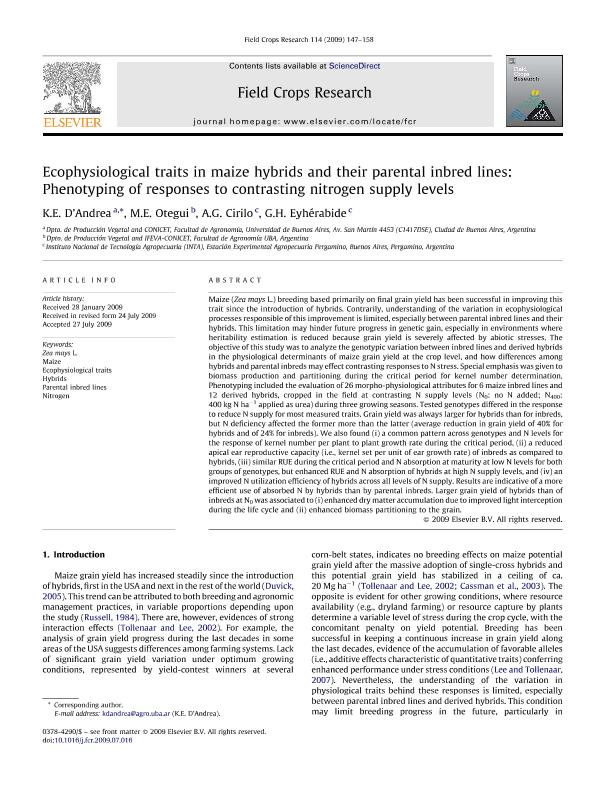Artículo
Ecophysiological traits in maize hybrids and their parental inbred lines: Phenotyping of responses to contrasting nitrogen supply levels
D'andrea, Karina Elizabeth ; Otegui, Maria Elena
; Otegui, Maria Elena ; Cirilo, Alfredo Gabriel; Eyherabide, Guillermo Hugo
; Cirilo, Alfredo Gabriel; Eyherabide, Guillermo Hugo
 ; Otegui, Maria Elena
; Otegui, Maria Elena ; Cirilo, Alfredo Gabriel; Eyherabide, Guillermo Hugo
; Cirilo, Alfredo Gabriel; Eyherabide, Guillermo Hugo
Fecha de publicación:
10/2009
Editorial:
Elsevier Science
Revista:
Field Crops Research
ISSN:
0378-4290
Idioma:
Inglés
Tipo de recurso:
Artículo publicado
Clasificación temática:
Resumen
Maize (Zea mays L.) breeding based primarily on final grain yield has been successful in improving this trait since the introduction of hybrids. Contrarily, understanding of the variation in ecophysiological processes responsible of this improvement is limited, especially between parental inbred lines and their hybrids. This limitation may hinder future progress in genetic gain, especially in environments where heritability estimation is reduced because grain yield is severely affected by abiotic stresses. The objective of this study was to analyze the genotypic variation between inbred lines and derived hybrids in the physiological determinants of maize grain yield at the crop level, and how differences among hybrids and parental inbreds may effect contrasting responses to N stress. Special emphasis was given to biomass production and partitioning during the critical period for kernel number determination. Phenotyping included the evaluation of 26 morpho-physiological attributes for 6 maize inbred lines and 12 derived hybrids, cropped in the field at contrasting N supply levels (N0: no N added; N400: 400 kg N ha-1 applied as urea) during three growing seasons. Tested genotypes differed in the response to reduce N supply for most measured traits. Grain yield was always larger for hybrids than for inbreds, but N deficiency affected the former more than the latter (average reduction in grain yield of 40% for hybrids and of 24% for inbreds). We also found (i) a common pattern across genotypes and N levels for the response of kernel number per plant to plant growth rate during the critical period, (ii) a reduced apical ear reproductive capacity (i.e., kernel set per unit of ear growth rate) of inbreds as compared to hybrids, (iii) similar RUE during the critical period and N absorption at maturity at low N levels for both groups of genotypes, but enhanced RUE and N absorption of hybrids at high N supply levels, and (iv) an improved N utilization efficiency of hybrids across all levels of N supply. Results are indicative of a more efficient use of absorbed N by hybrids than by parental inbreds. Larger grain yield of hybrids than of inbreds at N0 was associated to (i) enhanced dry matter accumulation due to improved light interception during the life cycle and (ii) enhanced biomass partitioning to the grain.
Archivos asociados
Licencia
Identificadores
Colecciones
Articulos(IFEVA)
Articulos de INST.D/INV.FISIOLOGICAS Y ECO.VINCULADAS A L/AGRIC
Articulos de INST.D/INV.FISIOLOGICAS Y ECO.VINCULADAS A L/AGRIC
Articulos(OCA PQUE. CENTENARIO)
Articulos de OFICINA DE COORDINACION ADMINISTRATIVA PQUE. CENTENARIO
Articulos de OFICINA DE COORDINACION ADMINISTRATIVA PQUE. CENTENARIO
Citación
D'andrea, Karina Elizabeth; Otegui, Maria Elena; Cirilo, Alfredo Gabriel; Eyherabide, Guillermo Hugo; Ecophysiological traits in maize hybrids and their parental inbred lines: Phenotyping of responses to contrasting nitrogen supply levels; Elsevier Science; Field Crops Research; 114; 1; 10-2009; 147-158
Compartir
Altmétricas



